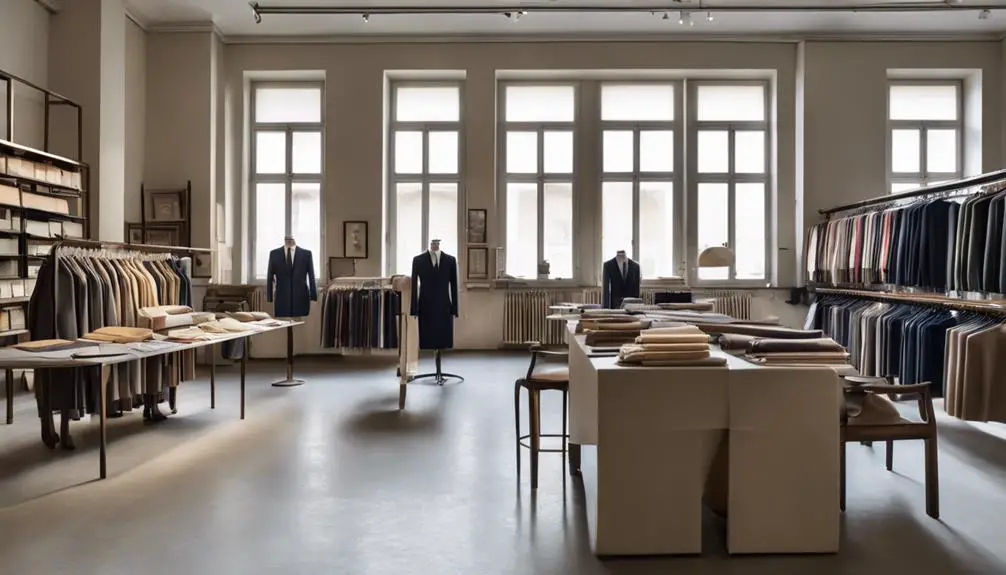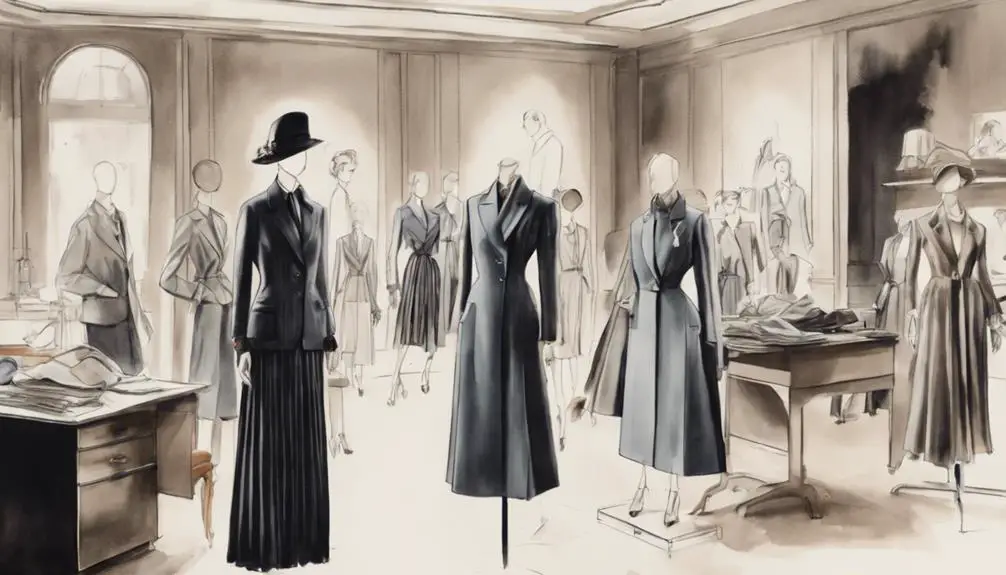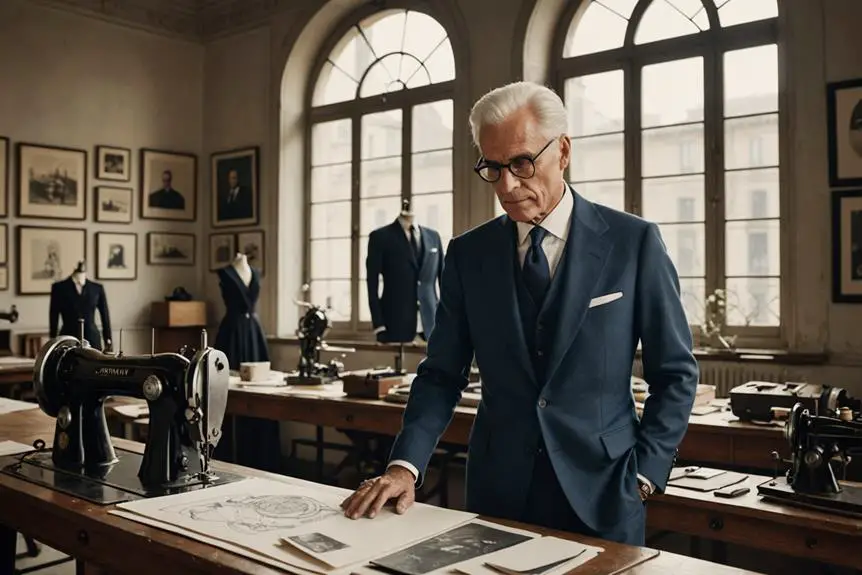When you consider the origins of the House of Armani, it's fascinating to see how Giorgio Armani and Sergio Galeotti transformed the fashion industry in the mid-1970s. Their innovative approach to menswear in 1976 began a journey that would redefine luxury and comfort, creating a signature style that resonated globally. But what drove their vision, and how did they navigate the challenges of a rapidly changing market? The answers reveal not just the birth of a brand but a deeper understanding of the cultural shifts that shaped modern fashion.
Origins of the Armani Brand

In the heart of Milan, the House of Armani was born in 1975, founded by Giorgio Armani and Sergio Galeotti. This partnership marked a pivotal moment in the fashion industry, as they aimed to redefine style with a commitment to elegance and innovation.
Just a year later, in 1976, Giorgio debuted his first menswear collection, which quickly gained acclaim for its forward-thinking designs and impeccable tailoring. This collection set the stage for the brand's future, showcasing a unique blend of sophistication and modernity that would become synonymous with Armani.
By 1977, the brand expanded into womenswear, further solidifying its identity and establishing pieces like the Armani jacket as essential elements of contemporary fashion. The success of these collections allowed the brand to grow rapidly, and in 1979, Armani took a significant step by establishing the Giorgio Armani Corporation to penetrate the U.S. market. This bold move enhanced brand visibility and dramatically increased demand for Armani's products.
As the early 1980s approached, Armani diversified his offerings, launching multiple product lines, including the popular Emporio Armani line aimed at younger consumers.
In 1988, a licensing agreement with L'Oréal for perfumes added another layer to the brand's expansive portfolio. Through these strategic decisions, Giorgio Armani and Sergio Galeotti laid the foundation for a brand that wouldn't only withstand the test of time but also lead a fashion revolution that still inspires designers today.
Early Innovations and Collections
How did Giorgio Armani manage to revolutionize menswear in the late 1970s? It all started with his groundbreaking ready-to-wear collection that debuted in 1976, which emphasized luxury and comfort, transforming the fashion industry.
By introducing deconstructed suits, Armani eliminated traditional padding, allowing for a relaxed silhouette and greater freedom of movement. This innovative approach didn't just redefine menswear; it set a new standard for style.
In 1977, Armani expanded his vision into womenswear, where he gained immediate acclaim for his elegant pantsuits. These designs challenged the conventional feminine aesthetic of the time, empowering women with a sophisticated yet comfortable alternative.
One of his standout pieces, the iconic Armani jacket, gained immense popularity, especially after actress Diane Keaton donned it in the film "Annie Hall." This moment solidified the jacket's status as a defining piece of modern fashion.
Armani's innovative designs were celebrated by the international press, who called his work "postmodern." This recognition not only highlighted his influence on contemporary fashion trends but also positioned him as a key player in the evolving fashion landscape.
With each collection, Armani blended elegance with practicality, appealing to a new generation of fashion enthusiasts. His ability to merge comfort with luxury, along with his commitment to innovative designs, set the foundation for a lasting legacy that continues to inspire the fashion industry today.
Key Collaborations and Partnerships

Giorgio Armani's innovative approach to fashion quickly attracted attention, paving the way for significant collaborations that would further elevate his brand. In 1978, he signed Armani's first licensing agreement with Gruppo Finanziario Tessile (GFT), allowing for the production of luxury ready-to-wear garments. This vital move laid a strong foundation for Armani's future endeavors.
The partnership with L'Oréal, established in 1980, marked a significant leap into the beauty industry. This collaboration led to the launch of Armani's first women's fragrance in 1982, followed by the first men's fragrance in 1984, which solidified his presence in the market.
Armani's collaborations with major filmmakers also played a fundamental role in enhancing brand visibility. He designed costumes for over a hundred films, including iconic appearances in "American Gigolo" and "The Untouchables," showcasing his design prowess on the silver screen.
In 2007, he formed a joint venture with Samsung, expanding into electronics and demonstrating the brand's versatility beyond fashion and lifestyle products. This partnership allowed Armani to tap into the tech-savvy market, blending style with functionality.
Additionally, the collaboration with Emaar Properties led to the launch of Armani Hotels, starting with the luxurious Armani Hotel Dubai in 2010. This marked a bold entry into the hospitality sector, illustrating Armani's commitment to providing an all-encompassing lifestyle experience.
Through these key collaborations and partnerships, the House of Armani continues to redefine luxury across various industries.
Expansion and Global Influence
The establishment of the Giorgio Armani Corporation in 1979 marked a pivotal moment in the brand's journey, as it enabled a strategic entry into the U.S. market. This expansion notably boosted brand visibility, particularly through high-profile endorsements, like Richard Gere's iconic role in "American Gigolo," where he donned Armani suits.
The introduction of the unstructured jacket in 1976 and the chic pantsuits of the 1980s played an essential role in defining modern fashion, emphasizing comfort and natural silhouettes iconic fashion innovations. By the late 1980s, you'd see the brand diversifying its product offerings, launching lines like Emporio Armani aimed at youth culture and Armani Casa for luxury home goods, which enriched its global presence.
As you explore Armani's international expansion, you can't help but admire the brand's growth. It began with its first retail store in Milan, paving the way for over 500 exclusive stores worldwide, a proof of its allure in the luxury fashion market.
The brand's collaborations with film and music stars further solidified its status, designing costumes for blockbuster films like "Miami Vice" and "Pulp Fiction."
Armani's commitment to innovation and quality guaranteed a strong foothold in the luxury segment, achieving a remarkable turnover of 2 billion USD by 2000. Its influence extended into Asia, especially China, where luxury spending surged, highlighting the brand's adaptability and vision.
With a current valuation of 3.1 billion USD, Giorgio Armani continues to set trends and redefine elegance, leaving an indelible mark on the global stage.
Legacy and Cultural Impact

Timeless elegance defines the legacy of Armani, as its innovative designs in the 1980s revolutionized fashion standards and reshaped societal views on gender-specific attire. For instance, the bold and sensual cuts that defined the era can be paralleled with the evolution of the Versace logo, showcasing how iconic brands have influenced contemporary fashion.
You can't overlook how pivotal Richard Gere's appearance in "American Gigolo" was, showcasing Armani's sleek deconstructed suits and elegant women's pantsuits. This moment not only solidified the brand's iconic status but also marked a significant evolution in both fashion and film history, elevating Armani's visibility in popular culture.
Armani's commitment to sustainability and ethical practices continues to set it apart in the luxury sector. Its recognition through the Visionary Award at the 2022 Sustainable Fashion Awards emphasizes the brand's influence on corporate responsibility within the industry. This forward-thinking approach reflects a growing awareness of ethical practices that resonate with today's conscientious consumers.
The establishment of the Armani Silos museum in Milan is another indication of the brand's cultural relevance, celebrating over 40 years of fashion history. Here, you'll find a rich narrative of innovation that not only highlights Armani's designs but also its impact on societal norms.
Moreover, Armani's philanthropic efforts, including support for sustainable fashion initiatives and contributions during the COVID-19 pandemic, reinforce its cultural impact as a socially responsible brand. By intertwining luxury with responsibility, Armani hasn't only created a lasting legacy but also inspired future generations to embrace both elegance and ethical practices in fashion.





I love your writing style truly enjoying this internet site.